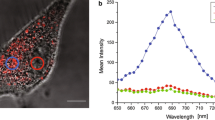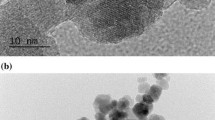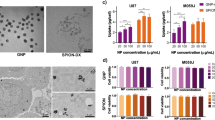Abstract
The synergy of superparamagnetic iron oxide nanoparticles (SPIONs) and ionizing radiation (IR), attributed to reactive oxygen species (ROS) and DNA double-strand breaks (DSBs) increase, was widely investigated in different cancers, but scarcely in melanoma. Herein, SPIONs were evaluated as radiosensitizers in A-375 human melanoma cells. Moreover, the effect of the combined treatment of SPIONs and gamma irradiation (SPIONs-IR) was assessed at the DNA level, where DSBs induction and their repair capacity were studied. SPIONs were synthesized, stabilized by poly(ethylene glycol) methyl ether and physicochemically characterized by high resolution-transmission electron microscopy (HR-TEM), X-ray diffraction and magnetometry and dynamic light scattering. The obtained nanoparticles showing superparamagnetic behavior and low dispersion in shape and sizes were tested in A-375 cells. The intracellular internalization of SPIONs was verified by HR-TEM and quantified by inductively coupled plasma atomic emission spectroscopy. Cells treated with SPIONs exhibited high ROS levels without associated cytotoxicity. Next, a significant radiosensitization in SPIONs-IR vs. control (IR) cells was demonstrated at 1 Gy of gamma radiation. Furthermore, a decreased DSBs repair capacity in SPIONs-IR vs. IR-treated cells was evidenced by the size increase of persistent phosphorylated H2AX foci at 24 h post-irradiation. In conclusion, these nanoparticles show the potential to radiosensitize melanoma cells by the induction of unrepairable DNA damage.







Similar content being viewed by others
Availability of data and materials
All data generated or analyzed during this study are included in this manuscript and they are available on reasonable request.
References
Bouras A, Kaluzova M, Hadjipanayis CG (2015) Radiosensitivity enhancement of radioresistant glioblastoma by epidermal growth factor receptor antibody-conjugated iron-oxide nanoparticles. J Neurooncol 124(1):13–22. https://doi.org/10.1007/s11060-015-1807-0
Bracalente C, Ibanez IL, Molinari B, Palmieri M, Kreiner A, Valda A, Davidson J, Duran H (2013) Induction and persistence of large gammaH2AX foci by high linear energy transfer radiation in DNA-dependent protein kinase-deficient cells. Int J Radiat Oncol Biol Phys 87(4):785–794. https://doi.org/10.1016/j.ijrobp.2013.07.014
Costes SV, Boissiere A, Ravani S, Romano R, Parvin B, Barcellos-Hoff MH (2006) Imaging features that discriminate between foci induced by high- and low-LET radiation in human fibroblasts. Radiat Res 165(5):505–515. https://doi.org/10.1667/RR3538.1
Costes SV, Chiolo I, Pluth JM, Barcellos-Hoff MH, Jakob B (2010) Spatiotemporal characterization of ionizing radiation induced DNA damage foci and their relation to chromatin organization. Mutat Res 704(1–3):78–87. https://doi.org/10.1016/j.mrrev.2009.12.006
Eccles LJ, O’Neill P, Lomax ME (2011) Delayed repair of radiation induced clustered DNA damage: friend or foe? Mutat Res 711(1–2):134–141. https://doi.org/10.1016/j.mrfmmm.2010.11.003
Egerton RF (2011) Electron energy-loss spectroscopy in the electron microscope, 3rd edn. Springer, New York. https://doi.org/10.1007/978-1-4419-9583-4
Espenel S, Vallard A, Rancoule C, Garcia MA, Guy JB, Chargari C, Deutsch E, Magne N (2017) Melanoma: last call for radiotherapy. Crit Rev Oncol Hematol 110:13–19. https://doi.org/10.1016/j.critrevonc.2016.12.003
Goswami N, Luo Z, Yuan X, Leong DT, Xie J (2017) Engineering gold-based radiosensitizers for cancer radiotherapy. Mater Horiz 4:817–831
Hartman RI, Lin JY (2019) Cutaneous melanoma-a review in detection, staging, and management. Hematol Oncol Clin N Am 33(1):25–38. https://doi.org/10.1016/j.hoc.2018.09.005
Hauser AK, Mitov MI, Daley EF, McGarry RC, Anderson KW, Hilt JZ (2016) Targeted iron oxide nanoparticles for the enhancement of radiation therapy. Biomaterials 105:127–135. https://doi.org/10.1016/j.biomaterials.2016.07.032
Ibanez IL, Bracalente C, Molinari BL, Palmieri MA, Policastro L, Kreiner AJ, Burlon AA, Valda A, Navalesi D, Davidson J, Davidson M, Vazquez M, Ozafran M, Duran H (2009) Induction and rejoining of DNA double strand breaks assessed by H2AX phosphorylation in melanoma cells irradiated with proton and lithium beams. Int J Radiat Oncol Biol Phys 74(4):1226–1235. https://doi.org/10.1016/j.ijrobp.2009.02.070
Ibanez IL, Bracalente C, Notcovich C, Tropper I, Molinari BL, Policastro LL, Duran H (2012) Phosphorylation and subcellular localization of p27Kip1 regulated by hydrogen peroxide modulation in cancer cells. PLoS ONE 7(9):e44502. https://doi.org/10.1371/journal.pone.0044502
Ibanez IL, Notcovich C, Catalano PN, Bellino MG, Duran H (2015) The redox-active nanomaterial toolbox for cancer therapy. Cancer Lett 359(1):9–19. https://doi.org/10.1016/j.canlet.2015.01.013
Khoshgard K, Kiani P, Haghparast A, Hosseinzadeh L, Eivazi MT (2017) Radiation dose rate affects the radiosensitization of MCF-7 and HeLa cell lines to X-rays induced by dextran-coated iron oxide nanoparticles. Int J Radiat Biol 93(8):757–763. https://doi.org/10.1080/09553002.2017.1321806
Kim JH, Kim SM, Kim YI (2014) Properties of magnetic nanoparticles prepared by co-precipitation. J Nanosci Nanotechnol 14(11):8739–8744. https://doi.org/10.1166/jnn.2014.9993
Klein S, Sommer A, Distel LV, Neuhuber W, Kryschi C (2012) Superparamagnetic iron oxide nanoparticles as radiosensitizer via enhanced reactive oxygen species formation. Biochem Biophys Res Commun 425(2):393–397. https://doi.org/10.1016/j.bbrc.2012.07.108
Lawrence MS, Stojanov P, Polak P, Kryukov GV, Cibulskis K, Sivachenko A, Carter SL, Stewart C, Mermel CH, Roberts SA, Kiezun A, Hammerman PS, McKenna A, Drier Y, Zou L, Ramos AH, Pugh TJ, Stransky N, Helman E, Kim J, Sougnez C, Ambrogio L, Nickerson E, Shefler E, Cortes ML, Auclair D, Saksena G, Voet D, Noble M, DiCara D, Lin P, Lichtenstein L, Heiman DI, Fennell T, Imielinski M, Hernandez B, Hodis E, Baca S, Dulak AM, Lohr J, Landau DA, Wu CJ, Melendez-Zajgla J, Hidalgo-Miranda A, Koren A, McCarroll SA, Mora J, Crompton B, Onofrio R, Parkin M, Winckler W, Ardlie K, Gabriel SB, Roberts CWM, Biegel JA, Stegmaier K, Bass AJ, Garraway LA, Meyerson M, Golub TR, Gordenin DA, Sunyaev S, Lander ES, Getz G (2013) Mutational heterogeneity in cancer and the search for new cancer-associated genes. Nature 499(7457):214–218. https://doi.org/10.1038/nature12213
Lee US, Lee DH, Kim EH (2022) Characterization of gamma-H2AX foci formation under alpha particle and X-ray exposures for dose estimation. Sci Rep 12(1):3761. https://doi.org/10.1038/s41598-022-07653-y
Liu Y, Peterson DA, Kimura H, Schubert D (1997) Mechanism of cellular 3-(4,5-dimethylthiazol-2-yl)-2,5-diphenyltetrazolium bromide (MTT) reduction. J Neurochem 69(2):581–593. https://doi.org/10.1046/j.1471-4159.1997.69020581.x
Liu W, Chen B, Zheng H, Xing Y, Chen G, Zhou P, Qian L, Min Y (2021) Advances of nanomedicine in radiotherapy. Pharmaceutics. https://doi.org/10.3390/pharmaceutics13111757
Lomax ME, Folkes LK, O’Neill P (2013) Biological consequences of radiation-induced DNA damage: relevance to radiotherapy. Clin Oncol 25(10):578–585. https://doi.org/10.1016/j.clon.2013.06.007
Ma J, Zhang Z, Huang J, Qin Y, Li X, Liu H, Yang K, Wu G (2015) Magnetic nanoparticle clusters radiosensitise human nasopharyngeal and lung cancer cells after alternating magnetic field treatment. Int J Hyperth 31(7):800–812. https://doi.org/10.3109/02656736.2015.1063168
Maeda H (2021) The 35th anniversary of the discovery of EPR effect: a new wave of nanomedicines for tumor-targeted drug delivery-personal remarks and future prospects. J Pers Med 11(3):229. https://doi.org/10.3390/jpm11030229
Rahman WN, Kadian SNM, Rashid RA, Abdullah R, Abdul Razak K, Pham BTT, Hawkett BS, Geso M (2019) Radiosensitization characteristic of superparamagnetic iron oxide nanoparticles in electron beam radiotherapy and brachytherapy. J Phys: Conf Ser 1248:012068
Reiniers MJ, de Haan LR, Reeskamp LF, Broekgaarden M, van Golen RF, Heger M (2021) Analysis and optimization of conditions for the use of 2’,7’-dichlorofluorescein diacetate in cultured hepatocytes. Antioxidants (basel) 10(5):674. https://doi.org/10.3390/antiox10050674
Reuben A, Spencer CN, Prieto PA, Gopalakrishnan V, Reddy SM, Miller JP, Mao X, De Macedo MP, Chen J, Song X, Jiang H, Chen PL, Beird HC, Garber HR, Roh W, Wani K, Chen E, Haymaker C, Forget MA, Little LD, Gumbs C, Thornton RL, Hudgens CW, Chen WS, Austin-Breneman J, Sloane RS, Nezi L, Cogdill AP, Bernatchez C, Roszik J, Hwu P, Woodman SE, Chin L, Tawbi H, Davies MA, Gershenwald JE, Amaria RN, Glitza IC, Diab A, Patel SP, Hu J, Lee JE, Grimm EA, Tetzlaff MT, Lazar AJ, Wistuba II, Clise-Dwyer K, Carter BW, Zhang J, Futreal PA, Sharma P, Allison JP, Cooper ZA, Wargo JA (2017) Genomic and immune heterogeneity are associated with differential responses to therapy in melanoma. NPJ Genom Med. https://doi.org/10.1038/s41525-017-0013-8
Roberts MJ, Bentley MD, Harris JM (2002) Chemistry for peptide and protein PEGylation. Adv Drug Deliv Rev 54(4):459–476. https://doi.org/10.1016/s0169-409x(02)00022-4
Rogers SJ, Puric E, Eberle B, Datta NR, Bodis SB (2019) Radiotherapy for melanoma: more than DNA damage. Dermatol Res Pract 2019:9435389. https://doi.org/10.1155/2019/9435389
Rothkamm K, Barnard S, Moquet J, Ellender M, Rana Z, Burdak-Rothkamm S (2015) DNA damage foci: meaning and significance. Environ Mol Mutagen 56(6):491–504. https://doi.org/10.1002/em.21944
Rybka JD (2019) Radiosensitizing properties of magnetic hyperthermia mediated by superparamagnetic iron oxide nanoparticles (SPIONs) on human cutaneous melanoma cell lines. Rep Pract Oncol Radiother 24(2):152–157. https://doi.org/10.1016/j.rpor.2019.01.002
Santivasi WL, Xia F (2014) Ionizing radiation-induced DNA damage, response, and repair. Antioxid Redox Signal 21(2):251–259. https://doi.org/10.1089/ars.2013.5668
Schlachter EK, Widmer HR, Bregy A, Lonnfors-Weitzel T, Vajtai I, Corazza N, Bernau VJ, Weitzel T, Mordasini P, Slotboom J, Herrmann G, Bogni S, Hofmann H, Frenz M, Reinert M (2011) Metabolic pathway and distribution of superparamagnetic iron oxide nanoparticles: in vivo study. Int J Nanomed 6:1793–1800. https://doi.org/10.2147/IJN.S23638
Schneider CA, Rasband WS, Eliceiri KW (2012) NIH image to ImageJ: 25 years of image analysis. Nat Methods 9(7):671–675. https://doi.org/10.1038/nmeth.2089
Schrand AM, Schlager JJ, Dai L, Hussain SM (2010) Preparation of cells for assessing ultrastructural localization of nanoparticles with transmission electron microscopy. Nat Protoc 5(4):744–757. https://doi.org/10.1038/nprot.2010.2
Shen Z, Song J, Yung BC, Zhou Z, Wu A, Chen X (2018) Emerging strategies of cancer therapy based on ferroptosis. Adv Mater 30(12):e1704007. https://doi.org/10.1002/adma.201704007
Shetake NG, Kumar A, Pandey BN (2019) Iron-oxide nanoparticles target intracellular HSP90 to induce tumor radio-sensitization. Biochim Biophys Acta 1863(5):857–869. https://doi.org/10.1016/j.bbagen.2019.02.010
Silva AH, Lima E Jr, Mansilla MV, Zysler RD, Troiani H, Pisciotti MLM, Locatelli C, Benech JC, Oddone N, Zoldan VC, Winter E, Pasa AA, Creczynski-Pasa TB (2016) Superparamagnetic iron-oxide nanoparticles mPEG350- and mPEG2000-coated: cell uptake and biocompatibility evaluation. Nanomed Nanotechnol Biol Med 12(4):909–919. https://doi.org/10.1016/j.nano.2015.12.371
Soetaert F, Korangath P, Serantes D, Fiering S, Ivkov R (2020) Cancer therapy with iron oxide nanoparticles: agents of thermal and immune therapies. Adv Drug Deliv Rev 163–164:65–83. https://doi.org/10.1016/j.addr.2020.06.025
Straczek T, Fiejdasz S, Rybicki D, Goc K, Przewoznik J, Mazur W, Nowakowska M, Zapotoczny S, Rumian S, Kapusta C (2019) Dynamics of superparamagnetic iron oxide nanoparticles with various polymeric coatings. Materials (basel) 12(11):1793. https://doi.org/10.3390/ma12111793
Tai MF, Lai CW, Hamid SBA (2016) Facile synthesis polyethylene glycol coated magnetite nanoparticles for high colloidal stability. J Nanomater 2016:8612505
Takahashi J, Nagasawa S (2020) Immunostimulatory effects of radiotherapy for local and systemic control of melanoma: a review. Int J Mol Sci 21(23):9324. https://doi.org/10.3390/ijms21239324
Talluri S, Malla RR (2019) Superparamagnetic iron oxide nanoparticles (SPIONs) for diagnosis and treatment of breast, ovarian and cervical cancers. Curr Drug Metab 20(12):942–945. https://doi.org/10.2174/1389200220666191016124958
van Gent DC, Hoeijmakers JH, Kanaar R (2001) Chromosomal stability and the DNA double-stranded break connection. Nat Rev Genet 2(3):196–206. https://doi.org/10.1038/35056049
Voinov MA, Sosa Pagan JO, Morrison E, Smirnova TI, Smirnov AI (2011) Surface-mediated production of hydroxyl radicals as a mechanism of iron oxide nanoparticle biotoxicity. J Am Chem Soc 133(1):35–41. https://doi.org/10.1021/ja104683w
Wang S, Luo J, Zhang Z, Dong D, Shen Y, Fang Y, Hu L, Liu M, Dai C, Peng S, Fang Z, Shang P (2018) Iron and magnetic: new research direction of the ferroptosis-based cancer therapy. Am J Cancer Res 8(10):1933–1946
Acknowledgements
The authors wish to thank Dr. Andrés J. Kreiner from Subgerencia de Tecnología y Aplicaciones de Aceleradores, Gerencia de Investigación y Aplicaciones, CNEA, Dr. Ana María Llois from Instituto de Nanociencia y Nanotecnología, CNEA-CONICET, Dr. Rubén Fernández from Laboratorio de Radiodosimetría Biológica and to the members of División Bioquímica Nuclear, Departamento de Radiobiología, CNEA, for their support; to CEBIRSA S.A. (Argentina) for the irradiation service and to Dr. Carlos Bertoli from Instituto de Nanociencia y Nanotecnología, CNEA-CONICET, Nodo Bariloche, for processing the melanoma cells samples for TEM.
Funding
This work was supported by Comisión Nacional de Energía Atómica, Argentina; Instituto de Nanociencia y Nanotecnología, CNEA-CONICET, Argentina; Consejo Nacional de Investigaciones Científicas y Técnicas, Argentina (PIP-11220170100098CO; PUE INN 2018) and by Agencia Nacional de Promoción Científica y Tecnológica, Argentina (PICT 2017-2478; PICT 2017-1239; PICT 2017-2519).
Author information
Authors and Affiliations
Contributions
CG: Formal analysis; Investigation; Methodology; Validation; Visualization; Writing—original draft; Writing—review & editing. MTP: Conceptualization; Formal analysis; Funding acquisition; Investigation; Methodology; Resources; Supervision; Validation; Writing—original draft; Writing—review & editing. MP: Formal analysis; Investigation; Methodology; Resources; Supervision; Validation; Writing—original draft; Writing—review & editing. MA: Investigation; Methodology; Writing—review & editing. LN: Formal analysis; Investigation; Methodology; Writing—review & editing. MSM: Formal analysis; Investigation; Methodology; Validation; Visualization; Writing—review & editing. JS: Investigation; Methodology; Visualization; Writing—review & editing. MSO: Investigation; Methodology; Visualization; Writing—review & editing. MdG: Formal analysis; Funding acquisition; Investigation; Methodology; Resources; Supervision; Validation; Writing—review & editing. HD: Conceptualization; Formal analysis; Funding acquisition; Investigation; Methodology; Project administration; Resources; Supervision; Writing—original draft; Writing—review & editing. ILI: Conceptualization; Formal analysis; Funding acquisition; Investigation; Methodology; Project administration; Resources; Supervision; Validation; Visualization; Writing—original draft; Writing—review & editing.
Corresponding authors
Ethics declarations
Competing interests
The authors declare no competing interests.
Conflict of interest
None.
Consent for publication and author’s role
All authors agreed to submit this manuscript.
Additional information
Publisher's Note
Springer Nature remains neutral with regard to jurisdictional claims in published maps and institutional affiliations.
Supplementary Information
Below is the link to the electronic supplementary material.
Rights and permissions
Springer Nature or its licensor (e.g. a society or other partner) holds exclusive rights to this article under a publishing agreement with the author(s) or other rightsholder(s); author self-archiving of the accepted manuscript version of this article is solely governed by the terms of such publishing agreement and applicable law.
About this article
Cite this article
Grissi, C., Taverna Porro, M., Perona, M. et al. Superparamagnetic iron oxide nanoparticles induce persistent large foci of DNA damage in human melanoma cells post-irradiation. Radiat Environ Biophys 62, 357–369 (2023). https://doi.org/10.1007/s00411-023-01037-0
Received:
Accepted:
Published:
Issue Date:
DOI: https://doi.org/10.1007/s00411-023-01037-0




